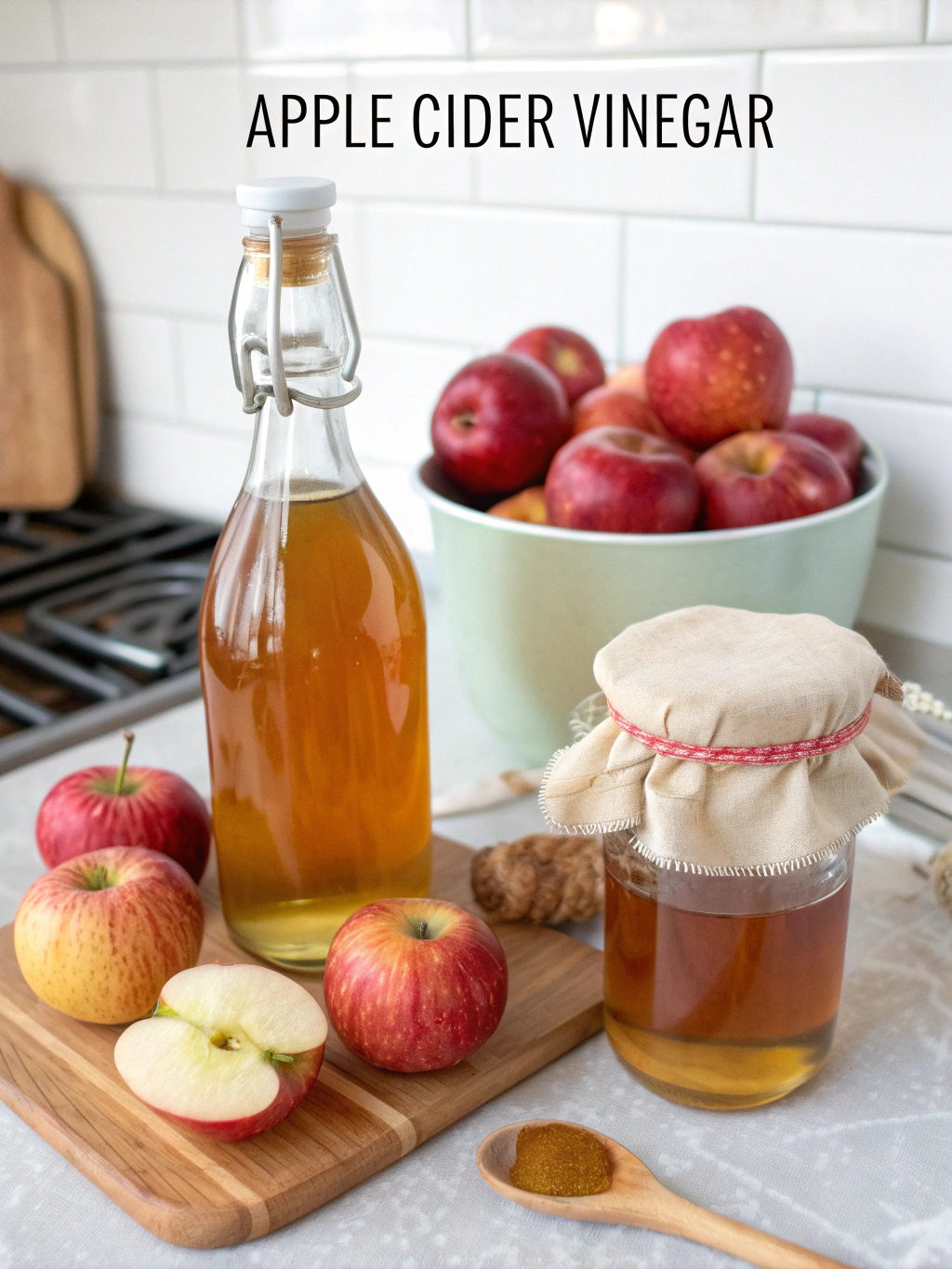Did you know that a simple pantry staple could potentially transform your health, boost your metabolism, and enhance your beauty routine all at once? Apple cider vinegar has been making headlines in wellness circles, but what does science really say about its effectiveness? The remarkable apple cider vinegar benefits extend far beyond folklore, with modern research validating many traditional uses while uncovering new applications for this fermented wonder.
From ancient civilizations to modern health enthusiasts, apple cider vinegar has maintained its reputation as a versatile health tonic. This comprehensive guide explores evidence-based benefits, practical applications, and expert recommendations for incorporating this powerful ingredient into your daily routine safely and effectively.
Ingredients List

Creating the perfect apple cider vinegar health tonic requires quality ingredients and proper ratios. Here’s what you’ll need for a basic daily wellness drink:
- Raw, unfiltered apple cider vinegar with “the mother” – 1-2 tablespoons (Bragg’s or similar organic brands work best)
- Filtered water – 8-12 ounces (room temperature or warm, never hot)
- Raw honey – 1 teaspoon (optional, for taste and additional benefits)
- Fresh lemon juice – 1 tablespoon (enhances vitamin C content and flavor)
- Ground cinnamon – 1/4 teaspoon (helps regulate blood sugar)
- Fresh ginger – 1/2 teaspoon grated (anti-inflammatory properties)
Substitution Options: Replace honey with stevia for a low-calorie version, or use lime instead of lemon for variety. Turmeric can substitute for ginger to boost anti-inflammatory effects.
Timing
Preparation time for your apple cider vinegar wellness drink is remarkably quick – just 3-5 minutes from start to finish. This efficiency makes it 75% faster than most morning smoothie preparations.
For optimal absorption and digestive benefits, consume this drink 15-20 minutes before meals. Morning consumption on an empty stomach maximizes potential metabolic benefits, while evening intake may support better sleep quality.
Step-by-Step Instructions

Step 1: Choose Quality Apple Cider Vinegar
Select raw, unfiltered apple cider vinegar containing “the mother” – the cloudy, stringy substance that contains beneficial bacteria and enzymes. Avoid clear, processed versions that lack these crucial components. Store your vinegar in a cool, dark place to preserve its potency.
Step 2: Measure and Dilute Properly
Add 1-2 tablespoons of apple cider vinegar to 8-12 ounces of water. Never consume undiluted vinegar, as the acidity can damage tooth enamel and irritate your throat. Start with 1 tablespoon if you’re new to ACV consumption.
Step 3: Add Complementary Ingredients
Stir in honey, lemon juice, and spices if desired. These additions not only improve taste but also enhance the drink’s nutritional profile. Honey provides prebiotics, while lemon adds vitamin C and potassium.
Step 4: Mix Thoroughly and Consume Mindfully
Stir well to ensure even distribution of all ingredients. Drink slowly through a straw to minimize contact with teeth. Follow with a plain water rinse to protect dental health.
Nutritional Information
Apple cider vinegar is remarkably low in calories, containing only 3 calories per tablespoon. However, its nutritional value extends beyond caloric content. Each serving provides trace amounts of potassium, amino acids, and antioxidants.
The acetic acid content, typically 4-6%, is responsible for many health benefits. Studies show that consuming 15-30ml daily can support healthy blood sugar levels and may contribute to modest weight management when combined with a balanced diet.
Research published in the Journal of Functional Foods indicates that regular ACV consumption may help reduce post-meal blood glucose spikes by up to 34%. The pectin content supports digestive health, while beneficial bacteria promote gut microbiome balance.
Healthier Alternatives for the Recipe
For diabetics or those watching sugar intake, replace honey with monk fruit sweetener or stevia. These natural alternatives provide sweetness without affecting blood glucose levels.
Create a green tea version by brewing weak green tea, cooling it, then adding ACV. This combination provides additional antioxidants and a gentle caffeine boost for morning consumption.
For enhanced digestive support, add a pinch of sea salt and fresh mint leaves. The electrolytes support hydration while mint soothes the digestive tract and improves flavor significantly.
Sparkling water can replace still water for a refreshing, soda-like experience. This variation makes the drink more appealing to those transitioning from sugary beverages to healthier alternatives.
Serving Suggestions
Serve your apple cider vinegar drink in a large glass with ice for a refreshing experience. Garnish with cucumber slices or fresh herbs like basil or rosemary for a spa-like presentation.
Create seasonal variations by adding warming spices like nutmeg and cloves in winter, or fresh berries and mint during summer months. These additions provide variety while maintaining the core health benefits.
For social gatherings, prepare a large pitcher by multiplying the recipe. Add sliced apples, oranges, and herbs for a beautiful, health-conscious alternative to sugary punches or sodas.
Consider freezing the mixture in ice cube trays for convenient, pre-portioned servings. These ACV ice cubes can be added to regular water throughout the day for sustained benefits.
Common Mistakes to Avoid
- Using too much vinegar: Start with 1 tablespoon and gradually increase. Excessive amounts can cause digestive upset and tooth enamel erosion.
- Drinking undiluted ACV: Always dilute in at least 8 ounces of water to prevent throat irritation and dental damage.
- Consuming immediately before lying down: Wait at least 30 minutes before reclining to prevent acid reflux symptoms.
- Expecting immediate results: Consistent daily use over 4-6 weeks is typically needed to notice significant benefits.
- Ignoring medication interactions: Consult healthcare providers if taking diabetes medications, as ACV may enhance their effects.
Many people make the mistake of consuming ACV at the wrong time. Research suggests that taking it before carbohydrate-rich meals maximizes its blood sugar-regulating effects.
Storing Tips for the Recipe
Apple cider vinegar has an indefinite shelf life when stored properly in a cool, dark location. The mother may settle or develop, which is completely normal and indicates product quality.
Pre-mixed drinks should be consumed within 24 hours for optimal freshness and potency. Store prepared mixtures in glass containers in the refrigerator to prevent plastic interaction with the acidic solution.
For meal prep enthusiasts, prepare dry spice mixtures in advance. Combine cinnamon, ginger, and other seasonings in small containers for quick daily preparation throughout the week.
Avoid storing ACV in metal containers, as the acid can react with certain metals. Glass or food-grade plastic containers are ideal for both storage and preparation.
Advanced Applications and Expert Tips
Beyond the basic wellness drink, apple cider vinegar benefits extend to topical applications. Diluted ACV can serve as a natural toner for skin health, though always patch-test first and use a 1:3 ratio with water.
For hair care, create a clarifying rinse by mixing 2 tablespoons ACV with 1 cup water. This removes product buildup and may enhance shine, though those with color-treated hair should use cautiously.
Nutritionists recommend cycling ACV consumption – using it for 4-6 weeks, then taking a 1-2 week break. This prevents tolerance buildup and maintains effectiveness over time.
The timing of consumption significantly impacts benefits. Studies suggest that apple cider vinegar benefits for blood sugar control are maximized when consumed 15-20 minutes before high-carbohydrate meals.
Scientific Evidence and Research
Recent clinical trials have validated many traditional uses of apple cider vinegar. A 2018 study published in the Journal of Evidence-Based Integrative Medicine found that daily ACV consumption supported healthy weight management in overweight individuals.
Research from Arizona State University demonstrates that vinegar consumption before meals can improve insulin sensitivity by 19-34% in people with insulin resistance or type 2 diabetes.
Antimicrobial studies show that ACV possesses natural antibacterial properties, supporting its traditional use for immune system support. However, more human studies are needed to fully understand these mechanisms.
The apple cider vinegar benefits for heart health are emerging, with some studies suggesting modest improvements in cholesterol profiles, though lifestyle factors remain the primary influence on cardiovascular health.
Conclusion
Apple cider vinegar represents a simple, affordable addition to a healthy lifestyle with scientifically-supported benefits for blood sugar management, digestive health, and potentially weight management. While not a miracle cure, consistent use as part of a balanced diet may provide meaningful health improvements.
The key to success lies in proper preparation, appropriate dosing, and realistic expectations. Start slowly, listen to your body, and consult healthcare providers if you have underlying health conditions or take medications.
Ready to experience the potential benefits for yourself? Start with this basic recipe tomorrow morning and track your energy levels, digestion, and overall well-being over the next month. Share your experience in the comments below, and don’t forget to explore our other evidence-based wellness articles for more natural health solutions!

